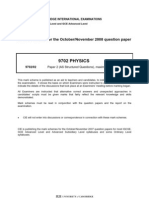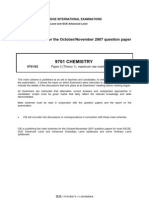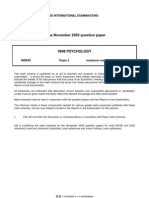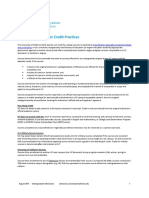9702 PHYSICS: MARK SCHEME For The May/June 2013 Series
9702 PHYSICS: MARK SCHEME For The May/June 2013 Series
Uploaded by
Ali ArshadCopyright:
Available Formats
9702 PHYSICS: MARK SCHEME For The May/June 2013 Series
9702 PHYSICS: MARK SCHEME For The May/June 2013 Series
Uploaded by
Ali ArshadOriginal Description:
Original Title
Copyright
Available Formats
Share this document
Did you find this document useful?
Is this content inappropriate?
Copyright:
Available Formats
9702 PHYSICS: MARK SCHEME For The May/June 2013 Series
9702 PHYSICS: MARK SCHEME For The May/June 2013 Series
Uploaded by
Ali ArshadCopyright:
Available Formats
CAMBRIDGE INTERNATIONAL EXAMINATIONS
GCE Advanced Subsidiary Level and GCE Advanced Level
MARK SCHEME for the May/June 2013 series
9702 PHYSICS
9702/41 Paper 4 (A2 Structured Questions), maximum raw mark 100
This mark scheme is published as an aid to teachers and candidates, to indicate the requirements of the examination. It shows the basis on which Examiners were instructed to award marks. It does not indicate the details of the discussions that took place at an Examiners meeting before marking began, which would have considered the acceptability of alternative answers. Mark schemes should be read in conjunction with the question paper and the Principal Examiner Report for Teachers.
Cambridge will not enter into discussions about these mark schemes.
Cambridge is publishing the mark schemes for the May/June 2013 series for most IGCSE, GCE Advanced Level and Advanced Subsidiary Level components and some Ordinary Level components.
Page 2
Mark Scheme GCE AS/A LEVEL May/June 2013 Section A
Syllabus 9702
Paper 41
(a) region of space area / volume where a mass experiences a force (b) (i) force proportional to product of two masses force inversely proportional to the square of their separation either reference to point masses or separation >> size of masses (ii) field strength = GM / x2 or field strength 1 / x2 ratio = (7.78 108)2 / (1.5 108)2 = 27 (c) (i) either centripetal force = mR2 and = 2 / T or centripetal force = mv2 / R and v = 2R /T gravitational force provides the centripetal force either GMm / R2 = mR2 or GMm / R2 = mv2 / R M = 42R3 / GT2 (allow working to be given in terms of acceleration) (ii) M = {42 (1.5 1011)3} / {6.67 1011 (3.16 107)2} = 2.0 1030 kg
B1 B1 M1 M1 A1 C1 C1 A1
[2]
[3]
[3]
B1 B1 M1 A0
[3]
C1 A1
[2]
(a) obeys the equation pV = constant T or pV = nRT p, V and T explained at all values of p, V and T/fixed mass/n is constant (b) (i) 3.4 105 2.5 103 106 = n 8.31 300 n = 0.34 mol (ii) for total mass/amount of gas 3.9 105 (2.5 + 1.6) 103 106 = (0.34 + 0.20) 8.31 T T = 360 K (c) when tap opened gas passed (from cylinder B) to cylinder A work done on gas in cylinder A (and no heating) so internal energy and hence temperature increase
M1 A1 A1
[3]
M1 A0
[1]
C1 A1
[2]
B1 M1 A1
[3]
Cambridge International Examinations 2013
Page 3 3 (a) (i) 1. 2.
Mark Scheme GCE AS/A LEVEL May/June 2013 amplitude = 1.7 cm period = 0.36 cm frequency = 1/0.36 frequency = 2.8 Hz
Syllabus 9702
Paper 41 A1 C1 A1 C1 M1 A0 M1 A1 [2] [1]
(ii) a = ()2x and = 2/T acceleration = (2/0.36)2 1.7 102 = 5.2 m s2 (b) graph: straight line, through origin, with negative gradient from (1.7 102, 5.2) to (1.7 102, 5.2) (if scale not reasonable, do not allow second mark)
[2]
[2]
(c) either kinetic energy = m2(x02 x2) or potential energy = m2x2 and potential energy = kinetic energy 2 m (x0 x2) = m2x02 or m2x2 = m2x02 x02 = 2x2 x = x0 / 2 = 1.7 / 2 = 1.2 cm 4 (a) work done moving unit positive charge from infinity (to the point) (b) (gain in) kinetic energy = change in potential energy mv2 = qV leading to v = (2Vq/m) (c) either (2.5 105)2 = 2 V 9.58 107 V = 330 V this is less than 470 V and so no v = (2 470 9.58 107) v = 3.0 105 m s1 this is greater than 2.5 105 m s1 and so no (2.5 105)2 = 2 470 (q/m) (q/m) = 6.6 107 C kg1 this is less than 9.58 107 C kg1 and so no
B1 C1 A1 M1 A1 B1 B1 [3]
[2]
[2]
C1 M1 A1 (C1) (M1) (A1) (C1) (M1) (A1)
[3]
or
or
Cambridge International Examinations 2013
Page 4 5
Mark Scheme GCE AS/A LEVEL May/June 2013
Syllabus 9702
Paper 41 M1 A1 [2]
(a) (uniform magnetic) flux normal to long (straight) wire carrying a current of 1 A (creates) force per unit length of 1 N m1 (b) (i) flux density = 4 107 1.5 103 3.5 = 6.6 103 T (ii) flux linkage = 6.6 103 28 104 160 = 3.0 103 Wb (c) (i) (induced) e.m.f. proportional to rate of change of (magnetic) flux (linkage) (ii) e.m.f. = (2 3.0 103) / 0.80 = 7.4 103 V
C1 A1 C1 A1 M1 A1 C1 A1 B1 B1 B1
[2]
[2]
[2]
[2]
(a) (i) to reduce power loss in the core due to eddy currents/induced currents (ii) either or (b) either no power loss in transformer input power = output power
[2] [1]
or
r.m.s. voltage across load = 9.0 (8100 / 300) peak voltage across load = 2 243 = 340 V peak voltage across primary coil = 9.0 2 peak voltage across load = 12.7 (8100/300) = 340 V
C1 A1 [2] (C1) (A1) M1 A1 C1 A1 [2]
(a) (i) lowest frequency of e.m. radiation giving rise to emission of electrons (from the surface) (ii) E = hf threshold frequency = (9.0 1019) / (6.63 1034) = 1.4 1015 Hz (b) either 300 nm 10 1015 Hz (and 600 nm 5.0 1014 Hz) or 300 nm 6.6 1019 J (and 600 nm 3.3 1019 J) or zinc 0 = 340 nm, platinum 0 = 220 nm (and sodium 0 = 520 nm) emission from sodium and zinc (c) each photon has larger energy fewer photons per unit time fewer electrons emitted per unit time
[2]
M1 A1 M1 M1 A1
[2]
[3]
Cambridge International Examinations 2013
Page 5 8
Mark Scheme GCE AS/A LEVEL May/June 2013
Syllabus 9702
Paper 41 M1 A1 [2]
(a) two (light) nuclei combine to form a more massive nucleus (b) (i) m
= (2.01410 u + 1.00728 u) 3.01605 u = 5.33 103 u energy = c2 m = 5.33 103 1.66 1027 (3.00 108)2 = 8.0 1013 J
C1 C1 A1 B1 B1 [3] [2]
(ii) speed/kinetic energy of proton and deuterium must be very large so that the nuclei can overcome electrostatic repulsion Section B 9 (a) (i) light-dependent resistor/LDR (ii) strain gauge (iii) quartz/piezo-electric crystal (b) (i) resistance of thermistor decreases as temperature increses etiher VOUT = V R / (R + RT) or current increases and VOUT = I R VOUT increases (ii) either change in RT with temperature is non-linear or VOUT is not proportional to RT/ change in VOUT with RT is non-linear so change is non-linear 10 (a) sharpness: how well the edges (of structures) are defined contrast: difference in (degree of) blackening between structures (b) e.g. scattering of photos in tissue/no use of a collimator/no use of lead grid large penumbra on shadow/large area anode/wide beam large pixel size (any two sensible suggestions, 1 each) (c) (i) I = I0ex ratio = exp(2.85 3.5) / exp(0.95 8.0) = (4.65 105) / (5.00 104) = 0.093 (ii) either large difference (in intensities) or ratio much less than 1.0 so good contrast (answer given in (c)(ii) must be consistent with ratio given in (c)(i))
B1 B1 B1 M1 A1 A1 M1 A1 B1 B1
[1] [1] [1]
[3]
[2]
[2]
B2
[2]
C1 C1 A1 M1 A1 [3]
[2]
Cambridge International Examinations 2013
Page 6
Mark Scheme GCE AS/A LEVEL May/June 2013
Syllabus 9702
Paper 41 M1 A1 [2]
11 (a) (i) amplitude of the carrier wave varies (in synchrony) with the displacement of the information signal (ii) e.g. more than one radio station can operate in same region/less interference enables shorter aerial increased range/less power required/less attenuation less distortion (any two sensible answers, 1 each) (b) (i) frequency = 909 kHz wavelength = (3.0 108) / (909 103) = 330 m (ii) bandwidth = 18 kHz (iii) frequency = 9000 Hz 12 (a) for received signal, 28 = 10 lg(P / {0.36 106}) P = 2.3 104 W (b) loss in fibre = 10 lg({9.8 103} / {2.27 104}) = 16 dB (c) attenuation per unit length = 16 / 85 = 0.19 dB km1
B2 C1 A1 A1 A1
[2]
[2] [1] [1]
C1 A1
[2]
C1 A1
[2]
A1
[1]
Cambridge International Examinations 2013
You might also like
- 9702 PHYSICS: MARK SCHEME For The May/June 2011 Question Paper For The Guidance of TeachersNo ratings yet9702 PHYSICS: MARK SCHEME For The May/June 2011 Question Paper For The Guidance of Teachers6 pages
- MARK SCHEME For The June 2005 Question Paper: University of Cambridge International Examinations GCE Advanced LevelNo ratings yetMARK SCHEME For The June 2005 Question Paper: University of Cambridge International Examinations GCE Advanced Level6 pages
- MARK SCHEME For The June 2005 Question PaperNo ratings yetMARK SCHEME For The June 2005 Question Paper7 pages
- Mark Scheme Maximum Mark: 60 Syllabus/Component: 8702/2 Physics (Structured Questions)No ratings yetMark Scheme Maximum Mark: 60 Syllabus/Component: 8702/2 Physics (Structured Questions)4 pages
- 9702 PHYSICS: MARK SCHEME For The May/June 2012 Question Paper For The Guidance of TeachersNo ratings yet9702 PHYSICS: MARK SCHEME For The May/June 2012 Question Paper For The Guidance of Teachers7 pages
- Smkts PHYSICS 960/3/P3: Trial STPM Semester 3 STPM 2019No ratings yetSmkts PHYSICS 960/3/P3: Trial STPM Semester 3 STPM 20196 pages
- Gce Advanced Subsidiary Level and Advanced Level: Mark Scheme Maximum Mark: 60No ratings yetGce Advanced Subsidiary Level and Advanced Level: Mark Scheme Maximum Mark: 604 pages
- SMK Tinggi Klang Trial Term 1 2014 Marking SchemeNo ratings yetSMK Tinggi Klang Trial Term 1 2014 Marking Scheme6 pages
- Cambridge International Examinations Cambridge International Advanced Subsidiary and Advanced LevelNo ratings yetCambridge International Examinations Cambridge International Advanced Subsidiary and Advanced Level5 pages
- 0607 Cambridge International Mathematics: MARK SCHEME For The May/June 2012 Question Paper For The Guidance of TeachersNo ratings yet0607 Cambridge International Mathematics: MARK SCHEME For The May/June 2012 Question Paper For The Guidance of Teachers7 pages
- Mark Scheme January 2002 GCE: Physics A Unit PA08No ratings yetMark Scheme January 2002 GCE: Physics A Unit PA085 pages
- 10.6 Work Energy - Power CIE IAL Physics MS Theory UnlockedNo ratings yet10.6 Work Energy - Power CIE IAL Physics MS Theory Unlocked5 pages
- 9792 PHYSICS: MARK SCHEME For The May/June 2013 SeriesNo ratings yet9792 PHYSICS: MARK SCHEME For The May/June 2013 Series13 pages
- University of Cambridge International ExaminationsNo ratings yetUniversity of Cambridge International Examinations5 pages
- Cambridge International Examinations Cambridge International Advanced Subsidiary and Advanced LevelNo ratings yetCambridge International Examinations Cambridge International Advanced Subsidiary and Advanced Level7 pages
- 9702 PHYSICS: MARK SCHEME For The May/June 2013 SeriesNo ratings yet9702 PHYSICS: MARK SCHEME For The May/June 2013 Series4 pages
- University of Cambridge International ExaminationsNo ratings yetUniversity of Cambridge International Examinations4 pages
- Maximum Mark: 60: Cambridge International Advanced Subsidiary and Advanced LevelNo ratings yetMaximum Mark: 60: Cambridge International Advanced Subsidiary and Advanced Level6 pages
- 9792 PHYSICS: MARK SCHEME For The May/June 2010 Question Paper For The Guidance of TeachersNo ratings yet9792 PHYSICS: MARK SCHEME For The May/June 2010 Question Paper For The Guidance of Teachers14 pages
- Analytical Modeling of Solute Transport in Groundwater: Using Models to Understand the Effect of Natural Processes on Contaminant Fate and TransportFrom EverandAnalytical Modeling of Solute Transport in Groundwater: Using Models to Understand the Effect of Natural Processes on Contaminant Fate and TransportNo ratings yet
- Hyrdoacoustic Ocean Exploration: Theories and Experimental ApplicationFrom EverandHyrdoacoustic Ocean Exploration: Theories and Experimental ApplicationNo ratings yet
- 3D Modeling of Nonlinear Wave Phenomena on Shallow Water SurfacesFrom Everand3D Modeling of Nonlinear Wave Phenomena on Shallow Water SurfacesNo ratings yet
- Dynamic Damage and FragmentationFrom EverandDynamic Damage and FragmentationDavid Edward LambertNo ratings yet
- Characteristic Modes: Theory and Applications in Antenna EngineeringFrom EverandCharacteristic Modes: Theory and Applications in Antenna EngineeringNo ratings yet
- MARK SCHEME For The October 2007 Question Paper: Cambridge International Diploma in IctNo ratings yetMARK SCHEME For The October 2007 Question Paper: Cambridge International Diploma in Ict4 pages
- Syllabus: Cambridge International AS & A LevelNo ratings yetSyllabus: Cambridge International AS & A Level37 pages
- (Tài Liệu KYS) - Đọc Hiểu - Đọc Điền P.1No ratings yet(Tài Liệu KYS) - Đọc Hiểu - Đọc Điền P.140 pages
- 9713 Applied Information and Communication Technology: MARK SCHEME For The March 2016 SeriesNo ratings yet9713 Applied Information and Communication Technology: MARK SCHEME For The March 2016 Series6 pages
- MARK SCHEME For The November 2005 Question Paper: University of Cambridge International Examinations GCE A/AS LevelNo ratings yetMARK SCHEME For The November 2005 Question Paper: University of Cambridge International Examinations GCE A/AS Level5 pages
- Umair Ahmadh's A/L Result Sheet Screen Shot From WWW - Doenets.lkNo ratings yetUmair Ahmadh's A/L Result Sheet Screen Shot From WWW - Doenets.lk1 page
- 0455 Economics: MARK SCHEME For The May/June 2007 Question PaperNo ratings yet0455 Economics: MARK SCHEME For The May/June 2007 Question Paper3 pages
- 5070 Chemistry: MARK SCHEME For The October/November 2009 Question Paper For The Guidance of TeachersNo ratings yet5070 Chemistry: MARK SCHEME For The October/November 2009 Question Paper For The Guidance of Teachers4 pages
- IGCSE English Literature 2013 Summer Paper 4 Version 1 Marking SchemeNo ratings yetIGCSE English Literature 2013 Summer Paper 4 Version 1 Marking Scheme3 pages
- BTEC Level 3 Nationals Computing and IT GuideNo ratings yetBTEC Level 3 Nationals Computing and IT Guide14 pages
- Open University of Mauritius Undergraduate Programme SpecificationNo ratings yetOpen University of Mauritius Undergraduate Programme Specification17 pages
- MARK SCHEME For The November 2005 Question PaperNo ratings yetMARK SCHEME For The November 2005 Question Paper4 pages
- 2059 Pakistan Studies: MARK SCHEME For The May/June 2014 SeriesNo ratings yet2059 Pakistan Studies: MARK SCHEME For The May/June 2014 Series11 pages
- Pearson Edexcel A Level 0 NJKAEDN KKEBDJwmdnfm Bvhjewnd, FWBFDKJNVLW Kjfbkwhje MFKBW Qekmfnjwqbekljvak LNNo ratings yetPearson Edexcel A Level 0 NJKAEDN KKEBDJwmdnfm Bvhjewnd, FWBFDKJNVLW Kjfbkwhje MFKBW Qekmfnjwqbekljvak LN2 pages
- 9702 PHYSICS: MARK SCHEME For The May/June 2011 Question Paper For The Guidance of Teachers9702 PHYSICS: MARK SCHEME For The May/June 2011 Question Paper For The Guidance of Teachers
- MARK SCHEME For The June 2005 Question Paper: University of Cambridge International Examinations GCE Advanced LevelMARK SCHEME For The June 2005 Question Paper: University of Cambridge International Examinations GCE Advanced Level
- Mark Scheme Maximum Mark: 60 Syllabus/Component: 8702/2 Physics (Structured Questions)Mark Scheme Maximum Mark: 60 Syllabus/Component: 8702/2 Physics (Structured Questions)
- 9702 PHYSICS: MARK SCHEME For The May/June 2012 Question Paper For The Guidance of Teachers9702 PHYSICS: MARK SCHEME For The May/June 2012 Question Paper For The Guidance of Teachers
- Smkts PHYSICS 960/3/P3: Trial STPM Semester 3 STPM 2019Smkts PHYSICS 960/3/P3: Trial STPM Semester 3 STPM 2019
- Gce Advanced Subsidiary Level and Advanced Level: Mark Scheme Maximum Mark: 60Gce Advanced Subsidiary Level and Advanced Level: Mark Scheme Maximum Mark: 60
- Cambridge International Examinations Cambridge International Advanced Subsidiary and Advanced LevelCambridge International Examinations Cambridge International Advanced Subsidiary and Advanced Level
- 0607 Cambridge International Mathematics: MARK SCHEME For The May/June 2012 Question Paper For The Guidance of Teachers0607 Cambridge International Mathematics: MARK SCHEME For The May/June 2012 Question Paper For The Guidance of Teachers
- 10.6 Work Energy - Power CIE IAL Physics MS Theory Unlocked10.6 Work Energy - Power CIE IAL Physics MS Theory Unlocked
- 9792 PHYSICS: MARK SCHEME For The May/June 2013 Series9792 PHYSICS: MARK SCHEME For The May/June 2013 Series
- University of Cambridge International ExaminationsUniversity of Cambridge International Examinations
- Cambridge International Examinations Cambridge International Advanced Subsidiary and Advanced LevelCambridge International Examinations Cambridge International Advanced Subsidiary and Advanced Level
- 9702 PHYSICS: MARK SCHEME For The May/June 2013 Series9702 PHYSICS: MARK SCHEME For The May/June 2013 Series
- University of Cambridge International ExaminationsUniversity of Cambridge International Examinations
- Maximum Mark: 60: Cambridge International Advanced Subsidiary and Advanced LevelMaximum Mark: 60: Cambridge International Advanced Subsidiary and Advanced Level
- 9792 PHYSICS: MARK SCHEME For The May/June 2010 Question Paper For The Guidance of Teachers9792 PHYSICS: MARK SCHEME For The May/June 2010 Question Paper For The Guidance of Teachers
- Analytical Modeling of Solute Transport in Groundwater: Using Models to Understand the Effect of Natural Processes on Contaminant Fate and TransportFrom EverandAnalytical Modeling of Solute Transport in Groundwater: Using Models to Understand the Effect of Natural Processes on Contaminant Fate and Transport
- Hyrdoacoustic Ocean Exploration: Theories and Experimental ApplicationFrom EverandHyrdoacoustic Ocean Exploration: Theories and Experimental Application
- Acoustic Emission and Durability of Composite MaterialsFrom EverandAcoustic Emission and Durability of Composite Materials
- 3D Modeling of Nonlinear Wave Phenomena on Shallow Water SurfacesFrom Everand3D Modeling of Nonlinear Wave Phenomena on Shallow Water Surfaces
- Characteristic Modes: Theory and Applications in Antenna EngineeringFrom EverandCharacteristic Modes: Theory and Applications in Antenna Engineering
- MARK SCHEME For The October 2007 Question Paper: Cambridge International Diploma in IctMARK SCHEME For The October 2007 Question Paper: Cambridge International Diploma in Ict
- 9713 Applied Information and Communication Technology: MARK SCHEME For The March 2016 Series9713 Applied Information and Communication Technology: MARK SCHEME For The March 2016 Series
- MARK SCHEME For The November 2005 Question Paper: University of Cambridge International Examinations GCE A/AS LevelMARK SCHEME For The November 2005 Question Paper: University of Cambridge International Examinations GCE A/AS Level
- Umair Ahmadh's A/L Result Sheet Screen Shot From WWW - Doenets.lkUmair Ahmadh's A/L Result Sheet Screen Shot From WWW - Doenets.lk
- 0455 Economics: MARK SCHEME For The May/June 2007 Question Paper0455 Economics: MARK SCHEME For The May/June 2007 Question Paper
- 5070 Chemistry: MARK SCHEME For The October/November 2009 Question Paper For The Guidance of Teachers5070 Chemistry: MARK SCHEME For The October/November 2009 Question Paper For The Guidance of Teachers
- IGCSE English Literature 2013 Summer Paper 4 Version 1 Marking SchemeIGCSE English Literature 2013 Summer Paper 4 Version 1 Marking Scheme
- Open University of Mauritius Undergraduate Programme SpecificationOpen University of Mauritius Undergraduate Programme Specification
- 2059 Pakistan Studies: MARK SCHEME For The May/June 2014 Series2059 Pakistan Studies: MARK SCHEME For The May/June 2014 Series
- Pearson Edexcel A Level 0 NJKAEDN KKEBDJwmdnfm Bvhjewnd, FWBFDKJNVLW Kjfbkwhje MFKBW Qekmfnjwqbekljvak LNPearson Edexcel A Level 0 NJKAEDN KKEBDJwmdnfm Bvhjewnd, FWBFDKJNVLW Kjfbkwhje MFKBW Qekmfnjwqbekljvak LN

























































































